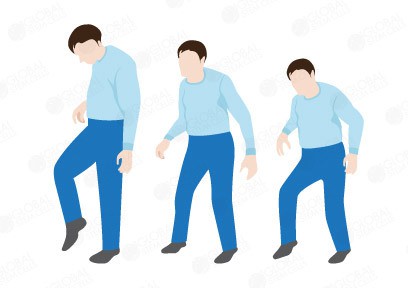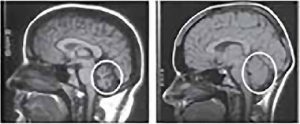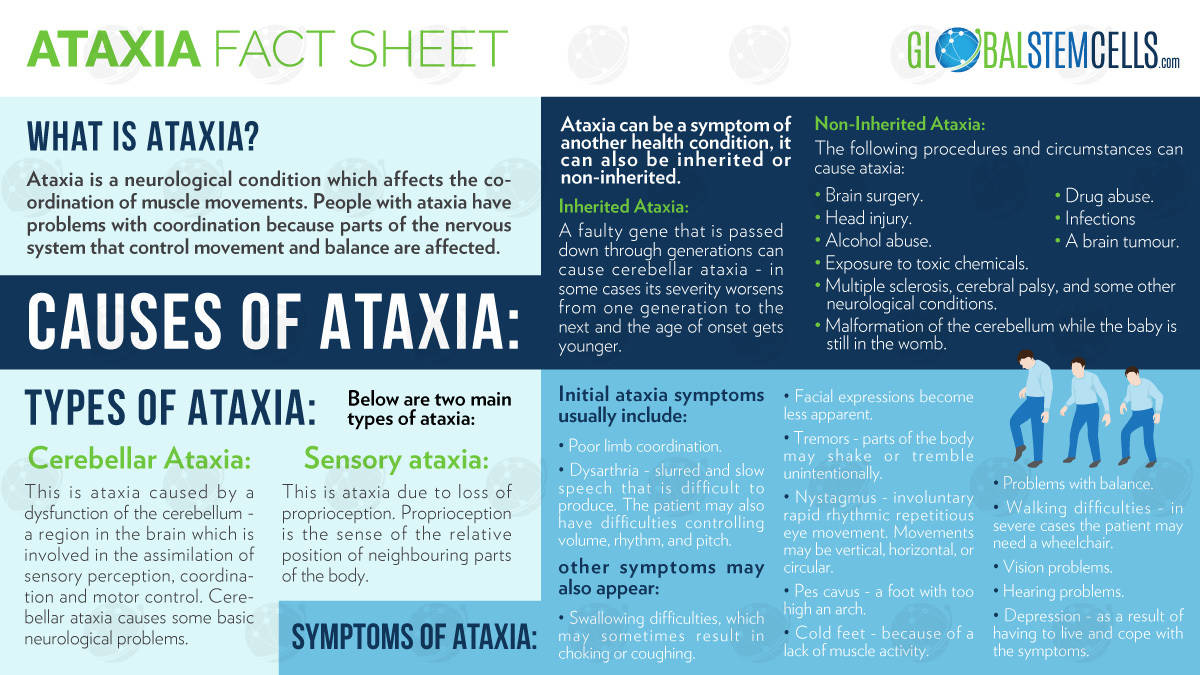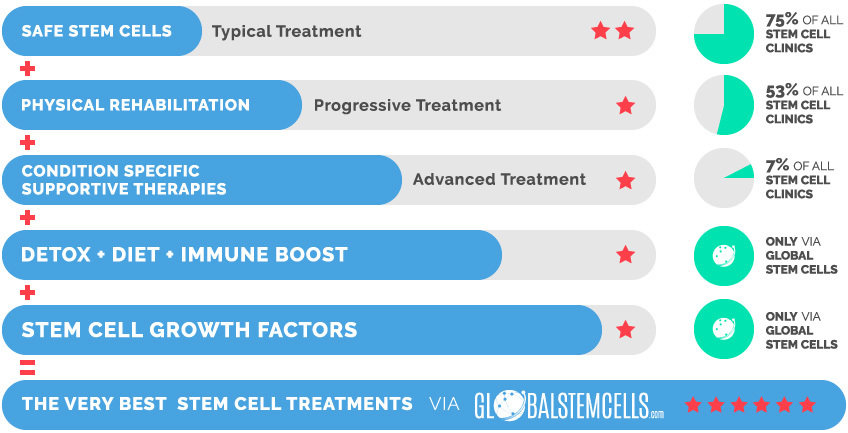
Unique Access provides access to an extensive treatment protocol for Ataxia which utilises higher quantities of stem cells, innovative stem cell growth factors, extensive rehabilitation, and many supportive therapies and supplements. This effective combination of the most advanced medical technologies with functional medicine has helped patients achieve significant improvements.
Why Stem Cells Work for Ataxia
Providing neuroprotection and possibly promoting regeneration are some of the reasons why stem cell therapies were recently studied as an option to treat neurodegenerative disorders.
In Ataxia, studies on animal models and humans also reported the therapeutic safety and efficacy of stem cell transplantation.
Mechanisms

There are multi-lineage differentiation potentials and immuno-modulatory properties in Mesenchymal Stem Cells (MSCs), and they are theoretically good candidates for treating SCA. It has also been shown that, under appropriate conditions, UC-MSC can differentiate into neurons.
By stimulating resident stem cells, anti-apoptotic effects, antioxidant effects and release of neurotrophic factors, MSCs can possibly protect axons and promote neurogenesis.
Possible Improvements

Ataxia patients have experienced remarkable improvements such as:
- Increased mobility
-
Better balance and coordination
(improvements are visible in Berg Balance Scale (BBS))
- Improved fine and gross motor skills
- Improved speech and cognition
Overall, a better quality of life was seen in most GSC patients treated using a combination of human Umbilical Cord-Derived Mesenchymal Stem cells (UC-MSC) and rehabilitation.
Disease progression was also observed to be significantly slower in patients with progressive Ataxias.
Our Promise
We believe that there is always hope and that patients deserve access to effective and safe treatments. We are independent with an in-house medical department. We combine internationally accredited hospitals, next generation treatments, unique products and services that are integrative and effective to ensure best possible treatment results.
Ataxia Patient Testimonials
Testimonial Disclaimer: All examples of what has been achieved by others should not be taken as typical or in any way a guarantee or projection of what any individual can expect from treatment.
Rosanne Sant tried to find the best treatment for Ataxia, but Australia had little to offer in this regard. She then sought for treatment abroad and found out about us. After doing her research and asked several questions, she decided to come to Thailand for Regenerative Treatment.
From her thoughts on her stem cell treatment to the members of the clinical staff, Pamela B discusses her stay at the hospital.
Stem Cells
We make sure that the patient receives the correct and necessary stem cell type, quality, quantity and viability. Our exclusive research partner guarantees a stem cell viability of 95%, many injections have a staggering viability of 98-99%.
Supportive Therapies & Remedies
- Hyperbaric Oxygen Chamber (HBOT)
- Hemo Oxygen Therapy (HOT)
- IV Vitamin Drips
- Immune-Boosting Supplements (e.g. GcMAF)
Partner Hospital
The treatment takes place in an internationally accredited tertiary care hospital and not in a hotel or clinic. This is important for the patient’s safety and care as the patient has access to all specialized departments & specialist doctors. This further increases the treatments efficiency.
What is Ataxia?
Ataxia is characterised by an inability to maintain normal posture and stable movements. Rather than being an actual disease, it is a sign and symptom of a central nervous system abnormality. The underlying neurological abnormality, resulting to this condition, can be either acquired or hereditary. Ethanol poisoning, lithium poisoning, anti-epileptic drugs, brain tumours, stroke, and cerebelittis are among the common acquired causes.

Hereditary Ataxias are a group of neurodegenerative disorders characterised by degenerative atrophy of the cerebellum, brain stem and/or spinal cord. Spinocerebellar Ataxia (SCA) and Friedreich’s Ataxia (FRDA) are its most common forms. Genetic anticipation usually occurs in familial patients, with symptoms and signs getting more severe with each successive generation.
The Very Best Stem Cell Treatments via globalstemcells.com

- Schmahmann JD (2004).
“Disorders of the cerebellum: ataxia, dysmetria of thought, and the cerebellar cognitive affective syndrome”. J Neuropsychiatry Clin Neurosci. 16 (3): 367–78. doi: 10.1176/appi.neuropsych.16.3.367. PMID 15377747.
- Bastian AJ, Zackowski KM, Thach WT (May 2000).
“Cerebellar ataxia: torque deficiency or torque mismatch between joints?”. J. Neurophysiol. 83 (5): 3019–30. PMID 10805697.
- van de Warrenburg BP, Steijns JA, Munneke M, Kremer BP, Bloem BR (April 2005).
“Falls in degenerative cerebellar ataxias”. Mov. Disord. 20 (4): 497–500. doi: 10.1002/mds.20375. PMID 15645525.
- Díez S (2009).
“Human health effects of methylmercury exposure”. Rev Environ Contam Toxicol. Reviews of Environmental Contamination and Toxicology. 198: 111–32. doi: 10.1007/978-0-387-09647-6_3. ISBN 978-0-387-09646-9. PMID 19253038.
- Spinazzi M, Angelini C, Patrini C (May 2010).
“Subacute sensory ataxia and optic neuropathy with thiamine deficiency”. Nature Reviews Neurology. 6 (5): 288–93. doi: 10.1038/nrneurol.2010.16. PMID 20308997.
- Jarius S, Wildemann B (2015).
“‘Medusa-head ataxia’: the expanding spectrum of Purkinje cell antibodies in autoimmune cerebellar ataxia. Part 1: Anti-mGluR1, anti-Homer-3, anti-Sj/ITPR1 and anti-CARP VIII”. Journal of Neuroinflammation. 12 (1): 166. doi: 10.1186/s12974-015-0356-y. PMID 26377085.
- Hadjivassiliou M, Sanders DS, Woodroofe N, Williamson C, Grünewald RA (2008).
“Gluten ataxia”. Cerebellum. 7 (3): 494–8. doi: 10.1007/s12311-008-0052-x. PMID 18787912.
- Forrest MD, Wall MJ, Press DA, Feng J (December 2012).
“The Sodium-Potassium Pump Controls the Intrinsic Firing of the Cerebellar Purkinje Neuron”. PLoS ONE. 7 (12): e51169. doi: 10.1371/journal.pone.0051169. PMC 3527461. PMID 23284664.
- Forrest MD (December 2014).
“The sodium-potassium pump is an information processing element in brain computation”. Frontiers in Physiology. 5 (472). doi: 10.3389/fphys.2014.00472.
- Calderon DP, Fremont R, Kraenzlin F, Khodakhah K (March 2011).
“The neural substrates of rapid-onset Dystonia-Parkinsonism”. Nature Neuroscience. 14 (3): 357–65. doi: 10.1038/nn.2753. PMC 3430603. PMID 21297628.


 English
English